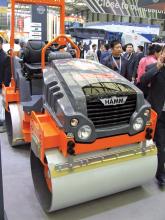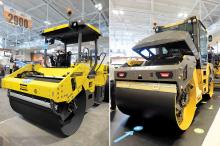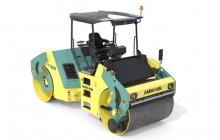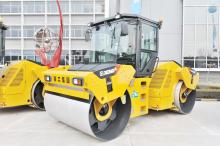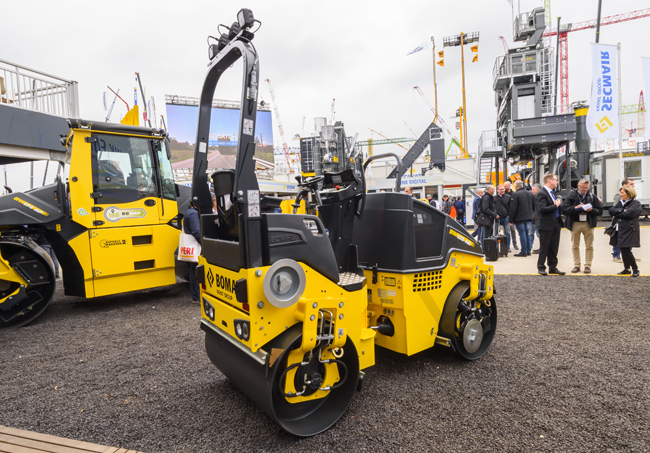
Advanced asphalt compactors are offering huge gains in performance over previous generation machines. Better working quality and finish is claimed for the latest machines, while future developments will offer sophisticated solutions.
The new ARX 91 articulated tandem roller from
According to the firm, the machine’s combination of its drum dimensions, frequency and amplitude settings help deliver versatility across a range of worksites. The novel drive system and wide range of compaction settings are said to provide a high output and allow optimum compaction results in a minimum number of passes. This high productivity is said to result in achieving the same. compaction output as larger machines from competing firms, while offering lower fuel consumption and operating and maintenance costs.
The machine is designed for use on medium to large jobsites, including both thin and thick layers of asphalt.
The ARX 91 model weighs in at 9tonnes and is powered by a
The machine has electronic joystick controls and is said to have a tight turning radius, while its water tank has a capacity of 1,000litres and is said to maximise the time between refills. The ARX 91 has maximum working speed of 7km/h, a maximum travel speed of 12km/h and gradeability of up to 40%.
It is also available with the Ammann Compaction Expert (ACE), the firm’s proprietary Intelligent Compaction system as an option. This package monitors density and provides feedback, helping to reduce the number of passes, while eliminating the risk of either over- or under-compaction.
A novel development from
The propane-fuelled variant has the same cost as a standard diesel and runs from standard 11kg gas bottles, which allow a running time of five hours and are readily available in most markets.
The electric model features four lithium ion cells and two electric motors, allowing an operating time of 1.5 hours and requiring a recharging time of 1.5 hours. Although this model has zero emissions, it costs two to three times that of the standard diesel model. BOMAG believes the lack of mains power for charging on many sites means the market may not be ready for this option yet. However, there may be applications where an all-electric roller may be preferable (such as in tunnels) and BOMAG is testing the market.
On a more conventional note, the firm is also offering the BW 120 with diesels that meet the Stage V emissions requirements. There is a model with a Kubota diesel engine delivering 24.3kW, as well as a lower rated version with an 18.5kW diesel and lower running costs.
The firm is also looking ahead to the future and has unveiled a more radical prototype. BOMAG’s innovative BW 154 compactor is an autonomous machine, with its most obvious feature being the absence of a cab. The machine, developed in partnership with
Jörg Unger, president of
This futuristic project will not be available for the market just yet, with the lack of necessary regulations being just one of the many factors preventing its deployment. Unger said: “We don’t expect that autonomous compaction will come in tomorrow but BOMAG and Fayat will be ready for this.”
Dynapac is introducing its sixth generation of asphalt compactors, the CO4200 - CO6200 models. The firm claims that the machines are easy to operate and offer high manoeuvrability and high- quality compaction. Key features include low emission engines and high vibration frequencies, as well as an advanced water system.
An improved driving position and visibility are important upgrades. The new generation Dynapac machines allows the seat and steering module to be swivelled and slide from the left side of the roller to the right. This allows the operator to see the drum edges. The seat can also swivel to be fully rear-facing when working backwards, while the instrument panel has been improved. And the electronic mini-steering wheel is said to make it easier to steer the roller accurately.
High vibration frequency compaction is said to suit duties in thin layers, which need to be compacted fast because they cool off quickly. The rollers can also be used for thick layers with high amplitude and conventional vibration frequencies.
Other benefits of the machines include reduced emissions and fuel consumption and extended service intervals. Different engines are available to suit local market requirements with Stage IV/Tier 4 Final units for Europe and North America and StageIIIA/Tier 3 for segments without the availability of low sulphur fuels.
Using oscillation ensures 100% ground contact and eliminating vertical vibration limits risk for damage also on less qualitative aggregates. Meeting state specifications requires that oscillations should be used while compacting on bridge decks, near foundations or concrete structures.
The oscillation system is suited to use when compacting thin lifts, bridge decks or in urban areas. The effect of the oscillating drum is to knead the asphalt surface rather than compacting it from above, resulting in the compaction forces being localised. This reduces disturbance in the area around the worksite as the resonances do not travel.
Arch rival
On a rather more conventional note, Hamm is improving the performance of one of its oscillatory type asphalt compactors. The DV+ 90i VS-OS model is now be able to cope with tighter turns due to the fitting of split drums. As a result, the machine can make a tighter turn while the exciter system is in use, without risk of damaging the surface being compacted.
A key feature of the machine is its new exciter configuration for the oscillator drum at the rear of the machine. This now has a separate, mechanically-independent oscillation unit that operates in each half of the split oscillation drum. Belt-driven, the system is also said to be maintenance-free, allowing it to last the lifetime of the compactor. Although the exciter units are separate, they are synchronised electro-hydraulically so that the same forces are applied. The system is said to react quickly and precisely, helping to optimise compaction performance.
The DV+ 90i VS-OS model also has a vibration system on its front drum, again with a split drum. Other features include the latest Easy Drive system, which is said to make the machine easier to use than earlier generation models.
Hamm is also introducing its HP series of rubber tyre rollers, which are now based on a common platform. This new generation of compactors is said to combine both proven and new features, with the Tier 3, Tier 4 and Stage V compliant models all sharing the same basic structure. The machines feature an asymmetrical frame design that is said to allow high compaction performance along with good all-round visibility.
Operating weights can vary from 8-28tonnes and the machines are available with various options, including a tyre inflation system, the edge pressing and cutting equipment and the new anti-slip system to maximise traction.
Other features include the firm’s proven Easy Drive system, as well as Hamm’s braking system and the ergonomic operator station.
Meanwhile, Mecalac is introducing its redesigned TV1200 tandem vibrating compaction. The roller is driven by a joystick on the right console, rather than a wheel on the steering column which is the usual set-up. This improves its efficiency, safety, comfort and ease of operation.
The normal position of the wheel on the steering column of a compact roller means the driver must contort himself just to get into the seat. Once in position, the driver operates the roller with one hand on the wheel and the other on the lever.
From
Power comes from a
The firm’s SW774ND model uses a similar chassis, but offers the choice of either vibration or oscillation on both of its 2m-wide drums, as with the larger SW888ND-1. The compaction systems for both machines are gear-driven, a design said to lower maintenance needs. The operator can use the machines in oscillation or vibration modes, depending on the job to be carried out. According to Sakai, having both drums equipped with both vibration and oscillation means that the number of passes can be halved, increasing productivity.

